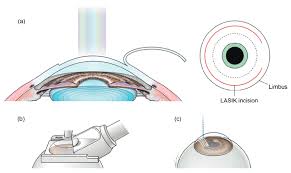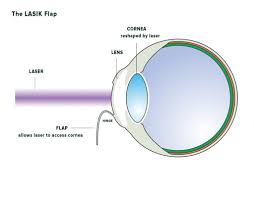Table of Contents
ToggleHow Does Ray Tracing Technology Help Create Precise Corneal Ablation Profiles?
The field of refractive surgery has undergone a remarkable transformation with the introduction of advanced technologies that enhance precision and customization.
One such breakthrough is the application of ray tracing technology in the WaveLight Plus InnovEyes system. This cutting-edge approach offers unprecedented accuracy in creating corneal ablation profiles, leading to improved visual outcomes for patients.
In this blog, we will explore how ray tracing works and its significance in the WaveLight Plus InnovEyes treatment process.
Understanding Ray Tracing Technology
Ray tracing is a well-established method originally used in physics and computer graphics to simulate how light interacts with various surfaces.
In the realm of ophthalmology, ray tracing extends beyond mere theoretical applications. It involves computational modelling of light paths through the eye’s optical system, providing detailed insights into how light behaves as it passes through different structures, such as the cornea, lens, and retina.
The Role of Ray Tracing in WaveLight Plus InnovEyes
The WaveLight Plus system leverages ray tracing technology to create highly detailed three-dimensional (3D) models of individual eyes. This process begins by gathering extensive biometric data through advanced diagnostic tools, including the SIGHTMAP device, which integrates various measurement modalities such as corneal topography, wavefront analysis, and interferometry.
Detailed Eye Modeling
The first step in the ray tracing process is the creation of a comprehensive 3D model of the eye. This model incorporates various measurements:
- Corneal Topography: This provides detailed information about the shape and curvature of the cornea, which is critical for determining how light will refract through it.
- Wavefront Analysis: This technique captures higher-order aberrations that standard methods may overlook, allowing for a more nuanced understanding of the eye’s optical performance.
- Biometric Measurements: Additional parameters, such as corneal thickness, anterior chamber depth, and axial length, contribute to the overall accuracy of the model.
By combining these data points, the WaveLight Plus system creates a precise digital representation of the patient’s eye, often referred to as the “eyevatar.”
Ray Tracing Algorithm in Action
This sophisticated software virtually traces thousands of light rays through the eye, simulating how these rays interact with the various optical surfaces. The process involves two primary steps:
- Forward Ray Tracing: The system calculates how light rays travel from the cornea to the lens, tracing their paths to determine how they will refract.
- Retrograde Ray Tracing: In this step, light rays are traced from the retina back to the lens, allowing the system to assess how changes to the corneal shape will affect the quality of vision.
By analyzing the interactions of these light rays, the system can identify and quantify aberrations that might affect visual acuity, ultimately leading to the calculation of an optimized ablation profile.
Creating Customized Ablation Profiles
The precision of ray tracing technology allows the WaveLight Plus system to generate highly customized corneal ablation profiles tailored to each patient’s unique optical characteristics. This is achieved through an automated software algorithm that calculates the necessary tissue removal required to correct both low and high-order aberrations.
Advantages of Customized Treatment Plans
- Improved Visual Quality: By addressing higher-order aberrations—such as spherical aberrations—ray tracing helps achieve sharper vision and better contrast sensitivity compared to traditional LASIK methods.
- Reduced Risk of Under- or Over-Correction: The precise calculations derived from the 3D model minimize the chances of residual refractive errors, a common issue in less customized treatments. This results in more predictable outcomes and greater satisfaction.
- Enhanced Patient Satisfaction: Customized treatment plans based on individual eye characteristics can lead to improved post-operative visual outcomes, contributing to higher patient satisfaction rates.
Automated Adjustments and Surgeon Input
One of the innovative features of the WaveLight Plus system is its ability to automate much of the treatment planning process. The software automatically generates a treatment plan based on the ray tracing analysis, moving away from the subjective manifest refraction methods used in earlier systems. While the initial ablation profile is predetermined by the software, surgeons still have the opportunity to make adjustments based on specific low-order aberration parameters, such as sphere, cylinder, and axis.
However, adjustments to higher-order aberrations, as calculated by the ray tracing analysis, remain fixed to ensure the integrity of the treatment plan. This automated approach significantly reduces the potential for human error, enhancing the overall accuracy and reliability of the procedure.
The Future of Ray Tracing in Refractive Surgery
The application of ray tracing technology in WaveLight Plus InnovEyes represents a pivotal advancement in refractive surgery. By allowing for detailed modelling of the eye and the precise calculation of ablation profiles, this technology is setting new standards for customization and accuracy in vision correction.
Toward “Eagle Vision”
The ultimate goal of using ray tracing technology is to go beyond traditional measures of visual acuity, aiming for what some refer to as “Eagle Vision.” This term describes the ability to achieve vision that exceeds the standard 20/20 measurement, providing patients with sharper, clearer sight that enhances their overall quality of life.
Continuous Improvement
As technology continues to evolve, so too will the capabilities of ray tracing in refractive surgery. Ongoing research and development promise to refine these techniques further, expanding the range of conditions that can be effectively treated and continually improving patient outcomes.
The Road Ahead
Ray tracing technology in the WaveLight Plus InnovEyes system marks a transformative leap in refractive surgery. By creating precise corneal ablation profiles through detailed 3D modelling and sophisticated algorithms, this innovative approach enhances the accuracy and effectiveness of vision correction procedures.
With its ability to customize treatment plans to the unique optical characteristics of each patient’s eye, ray tracing not only improves visual outcomes but also elevates patient satisfaction, paving the way for a brighter future in laser vision correction.
As advancements in this technology unfold, we can expect even more remarkable possibilities for achieving optimal vision for all patients.













